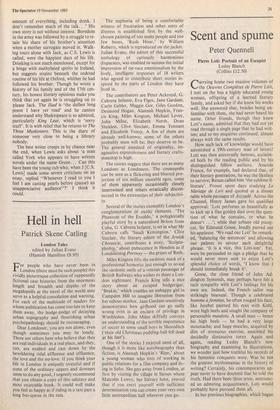Hell in hell
Patrick Skene Catling
London Tales edited by Julian Evans (Hamish Hamilton £8.95)
For people who have never been in London (there must be such people) this vividly picturesque collection of supposedly fictional case histories from the enormous length and breadth and depths of the megalopolis at the navel of the world may serve as a helpful consolation and warning. For each of the multitude of readers for whom publication has come too late to keep them away, the hodge-podge of decaying urban topography and flourishing urban psychopathology should be encouraging.
Dear Londoner, you are not alone, even though sometimes you may be lonely. There are others here who believe that they are real individuals in a real place, and they, too, are exalted and cast down by the bewildering tidal affluence and effluence, the love and the no-love. If you think your life in London is uniquely stressful and if none of the ordinary uppers and downers seem to do any good, I urgently recommend that you obtain a copy of this salutary and most enjoyable book. It could well make you feel as happy as if riding in a taxi past a long bus-queue in the rain. The euphoria of being a comfortable witness of frustration and other sorts of distress is established first by the well- chosen painting of too many people and too few buses, 'Rush Hour,' by William Roberts, which is reproduced on the jacket. Julian Evans, the editor of this successful anthology of curiously harmonious disparates, was enabled to sustain the initial impression of rat-race emotionalism by the lively, intelligent responses of 18 writers who agreed to contribute short stories in- spired by the parts of London they have lived in.
The contributors are Peter Ackroyd, G. Cabrera Infante, Eva Figes, Jane Gardam, Carlo Gebler, Maggie Gee, Giles Gordon, Desmond Hogan, Alannah Hopkin, Fran- cis King, Miles Kington, Michael Levey, John Milne, Elizabeth North, Dyan Sheldon, Clive Sinclair, Emma Tennant and Elizabeth Troop. A few of them are already well-known; some of the others probably soon will be; they deserve to be. The general standard of originality, im- aginative expressiveness and literary crafts- manship is high.
The stories suggest that there are as many Londons as Londoners. The cosmopolis can be seen as a flickering and blurred pro- jection of ten million unstable egos, some of them apparently occasionally closely intertwined and others erratically discon- nected in the extremities of their subjectivi- ty.
Several of the stories exemplify London's conglomeration of exotic elements. 'The Phantom of the Essoldo,' a polyglottally playful story by a naturalised Briton from Cuba, G. Cabrera Infante, is set in what Mr Cabrera calls 'Saudi Kensington.' Clive Sinclair, the literary editor of the Jewish Chronicle, contributes a story, 'Scripto- phobia,' about pubescence in Hendon as if LondOnising Portnoy — the gripes of Roth.
Miles Kington lifts the sardonic mask of a professional humorist just enough to reveal the sardonic smile of a veteran passenger of British Railways who wishes to share a Lon- don nightmare. Francis King tells a nice story about an escaped budgerigar, `Beakie,' which enables an unhappy girl in Campden Hill to imagine liberation from her odious mother. Jane Gardam sensitively demonstrates how girlhood can go sadly wrong even in an enclave of privilege in Wimbledon. John Milne skilfully conveys an understanding of the terrible importance of soccer to some small boys in Shoreditch (`their old Christmas-pudding-ball fell dead at his feet').
One of the stories I enjoyed most of all, though it is more like autobiography than fiction, is Alannah Hopkin's 'Ripe,' about a young woman who tires of working in public relations for a film company and liv- ing in Soho. She gets away from London, at first by visiting the village in Sussex where Malcolm Lowry, her literary hero, proved that if you exert yourself with sufficient determination you can create your very own little metropolitan hell wherever you go.


























































 Previous page
Previous page